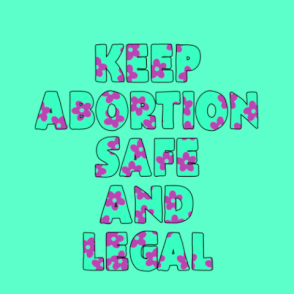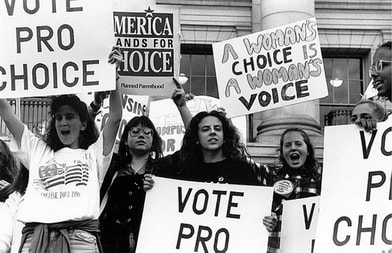LISTSOur biweekly lists lay out notable issues in the news and tell you what you can do about them.
|
SUBSCRIBE TO EMAIL UPDATES:
|
|
Teen Resisters-- we've been wanting to do this list for a while, and in the midst of the crazy news coming out of places like Alabama and Ohio, this seemed as good a time as any. We hope this list is informative, clarifying, and helpful. It was written by Stephanie Ulloa, Tali Natter, Kate Griem, and Sonia Chajet Wides. Reproductive Rights Glossary:Here are some key terms you might hear mentioned a lot, and what they mean:
A History of Repro Rights in the US:The fight for reproductive rights has been a key part of the Women’s Liberation Movement for a long, long time. Inequalities throughout history are largely driven by the same stereotypes and double standards that permeate our society today—from the beginning of human society, men have been rewarded for being sexually active, while women are often shamed and degraded. That historical misogyny affects anyone with a uterus, whether they be women or not-- some trans men, non-binary people, and intersex people can get pregnant (and get abortions) too. Those consequences for people with uteri exist not just in terms of perceptions but also in terms of tangible outcomes: people with uteri, not people without, are the ones who get pregnant, and so they are often responsible for providing birth control. Strangely, in law, it works the other way: people without uteri are often responsible for regulating birth control and abortion. And as the pregnancy progresses, it is physically much easier for the other partner to walk away than the pregnant person. Reproductive rights is an issue that disproportionately affects poor people, because pregnancy and parenthood, as well as abortions and birth control, can be expensive and hard to access. Abortion in the U.S.: A Brief History According to the National Abortion Federation, abortion has been performed for thousands of years in every society that we have studied. In the U.S. specifically, abortion didn’t start as a moral, religious, or ethical issue. Before the mid-to-late 1800s, when states began passing laws that made it illegal, it was simply a part of life. Drugs to induce abortion were common and public; if those didn’t work, people could visit practitioners for instrumental procedures. Abortion began to be politicized around 1860-1880 for a number of reasons. One was a widespread fear that the population would come to be dominated by the children of newly arriving immigrants, whose birth rates were higher than those of “native” Anglo-Saxon women (xenophobia, loud and clear!). Interestingly, this argument has switched to an equally disturbing side now: banning abortion is serviceable to systems that benefit from people being trapped in cycles of poverty and the population of the for-profit prison system. The other key reason was that the medical establishment wanted to eliminate their competition: the midwives, apothecaries, and homeopaths who often performed at-home abortions (and who took away patients and patient fees). The most effective way they saw of doing this was to make the procedure illegal, except in cases where the doctor determined that the woman’s life was threatened. This criminalization of abortion did not in any way diminish the number of people who sought it—although exact figures are unclear, the yearly number of illegal abortions in the years leading up to Roe v. Wade was over a million, and thousands of women died as a result of unsafe procedures. In 1973, Roe v. Wade established a woman’s fundamental right to choose whether or not to have an abortion; the Supreme Court ruled 7-2 that the Due Process Clause of the 14th Amendment establishes a “right to privacy” that protects a person’s right to abortion. Since then, restrictions on abortion have only increased. The first came soon after the Roe v. Wade decision. In 1976, the Hyde Amendment, named for its main sponsor Representative Henry Hyde, barred the use of federal funds to pay for abortion except when the pregnancy threatened the pregnant person’s life or if the pregnancy came from incest or rape. The Hyde Amendment has been instrumental in the justification of cutting funding for Planned Parenthood, which provides abortions among many other vital procedures like cancer screenings and pap smears. The exceptions for rape and incest are a difficult road to go down too-- we don’t have to remind you that the process of reporting a rape can be traumatic and lengthy, and it seems cruel to make people prove they were raped in order to get an abortion they might need (read more about this in this op-ed- TW: sexual assault). In 2017, Paul Ryan tried to push a bill that would make the Hyde Amendment permanent, but it didn’t pass the Senate. In 1992, Planned Parenthood of Southeastern Pennsylvania v. Casey weakened constitutional protection of abortion, establishing that state regulations are constitutional so long as they do not place a “substantial obstacle in the path of a woman seeking an abortion of a nonviable fetus.” In 2007, in Gonzales v. Carhart, the Supreme Court upheld President George W. Bush’s Federal Partial Birth Abortion Ban Act, the first federal law banning the “dilation and extraction” procedure, emboldening other states to pass more restrictive abortion laws as well. One other key case to be aware of is Whole Woman’s Health v. Hellerstedt: in 2016, in a victory for abortion rights activists the Supreme Court struck down a Texas law designed to shut down most of the state’s abortion clinics with medically unnecessary restrictions. Understanding a little bit about the legal history of the fight for abortion rights in the United States is key to understanding what the new Georgia and Alabama laws are trying to do right now. We only scratched the surface, so if you want to learn more about the legal history of abortion in the U.S., check out this article and this one. Also check out this article from NBC News for an important and less-told story. Birth Control: A Brief History The fight for universally accessible contraception originated during the Progressive Era, during the early 1900s specifically. Margaret Sanger,** a sex educator, writer, and nurse who coined the term “birth control,” fought for it for decades; her belief was that the ability to control family size was crucial to ending the cycle of women’s poverty. At the time, it was illegal to distribute birth control information, but she created her own publication (The Woman Rebel) to advocate for it nonetheless. She also opened the first birth control clinic in the United States (in Brownsville, Brooklyn), created the American Birth Control League (the organization that has evolved into what is Planned Parenthood today), and lobbied the government tirelessly until it became legal for doctors to prescribe birth control in 1936. In 1960, 6 years before her death, the birth control pill was invented, finally starting to separate sexuality from childbearing for a large number of women (and their partners). In 1965, Supreme Court case Griswold v. Connecticut established that laws prohibiting the sale of contraceptives violated the right to privacy and were therefore unconstitutional. This ban of prohibitive laws was extended to unmarried couples in Eisenstadt v. Baird in 1972, and a federal judge gave unmarried minors the right to purchase contraceptives in 1974 (yay safe teen sex!). Under the Affordable Care Act, many health insurance plans cover birth control. But, as we’re sure you can all guess, the Trump administration has attacked women’s access to birth control time and time again, way too many for us to talk about here (if you want to learn more about it, check out timelines of the attacks created by the National Women’s Law Center here and by Planned Parenthood here). **Setting aside the fact that she was a vital figure in the repro rights movement, it’s also important to recognize how problematic of a person she was. She was involved in the eugenics movement, which advocated for a process of selective breeding to weed out “undesirable” populations, including the mentally and physically disabled. Read more about it here.** So What's Happening Right Now?This recent Alabama law is the most severe, yet six other Republican-led states have passed the “heartbeat bill:” Georgia, Mississippi, Kentucky, Iowa, and North Dakota. (Missouri?) Heartbeat bills refer to a ban on abortions once a heartbeat can be detected at six weeks. Currently, the legal threshold for abortions is when the fetus is viable outside the womb, around 24 weeks. The heartbeat bills prohibit nearly all abortions because six weeks is often not enough time to confirm you are actually pregnant, decide what to do, find the funds, and set up an appointment to have the procedure done. Some women do not even know they are pregnant at six weeks (it’s just two weeks late for your period, as AOC pointed out). The bills are extremely restrictive and often don’t include exceptions for rape and incest, which, as we discussed earlier, aren’t even always that helpful anyway. More than 60 bills like this have been introduced across the country in states such as Louisiana, Missouri, South Carolina, Tennessee, Maryland, Minnesota, Texas, and West Virginia. Even in states considered safe havens for abortion rights, such as New York, anti-abortion lawmakers have introduced bills as a kind of protest, though they have not gotten far. These laws have not yet been enacted and abortion after six weeks is still legal. They have either not taken effect yet or have been blocked by a judge. Still, abortion providers are taking the threat seriously and are planning to use their funding to shuttle women across state lines to obtain abortions. These laws across the country are part of a larger effort to eventually overturn Roe V. Wade at the level of the Supreme Court. These restrictions are clearly unconstitutional and are used to pressure the Supreme Court to overturn Roe v. Wade or severely restrict how it is interpreted. Civil rights groups such as the ACLU are now tasked with the challenge to argue these laws in court to stop their implementation before they reach the highest court. And it's worth noting that the majority of Americans remain pro-choice and the majority of Americans oppose the Alabama laws. But for now, unless and until the supreme court speaks on one of these cases, abortion remains legal to the point a fetus can survive outside the womb in the US, 24 weeks. Even if states do not succeed in making abortion illegal, the pile-on of restrictions has already made its impact. There are fewer abortion providers with less funding, and thus the procedure is becoming more expensive and harder to find, making it ever more difficult for pregnant people to exercise their rights. Specific states: Alabama: Set to take effect six months after becoming law, sued by ACLU and PP Georgia: Set to take effect January 2020, but sued by the ACLU and the Center for Reproductive Rights Ohio: Set to take effect July 2019, but sued by the ACLU Mississippi: Set to take effect July 2019, but sued by the Center for Reproductive Rights Kentucky: Temporarily blocked by Judge David J. Hale after challenged in court by ACLU Iowa: Blocked permanently by Judge Michael Huppert North Dakota: Blocked permanently when the Supreme Court refused to review the ruling of a lower court Missouri: Signed by Governor What You Can Do:Specific to right now (May 2019): - Keep your eye out for marches and demonstrations. This summer will probably be chock-full of those opportunities! - Sign this ACLU petition. Head to aclu.org/action for lots of action tips customized to how much time you have available. - If you have the means, donate to the ACLU, Planned Parenthood, and the Yellowhammer Fund in Alabama right now- they're all doing imperative work to block these bans. - Check this NY Times graphic to see if your state has had an abortion ban or fetal heartbeat bill proposed. If it does, head here to find your state legislators and call them with this script: Hi, my name is ____and I live in ______. I'm calling to demand that you do everything you can to block abortion bans and fetal heartbeat bills proposed in our state. These bans and bills are unconstitutional, invasive, and cruel. (If you have a personal story, insert here.) Please keep in mind the millions of women and others who will be affected by these bans. Thank you for your time. - It's all about the courts-- stay updated on SCOTUS news. Repro Rights Constants:
And lastly, a puppy video: https://www.youtube.com/watch?v=_MnrWO-0f-Y
Sending love and light!
0 Comments
Leave a Reply. |
UPdatesThese lists include featured organizations, scripts, numbers, news updates and inspirational activists. Archives
January 2022
Categories |
About |
Content |
|


 RSS Feed
RSS Feed
